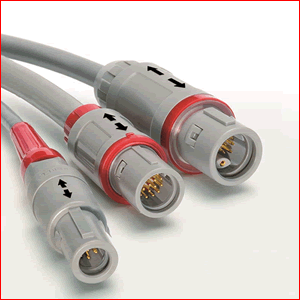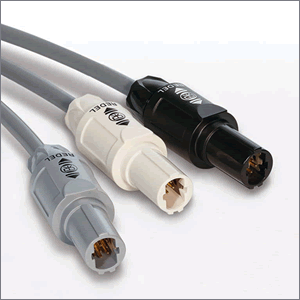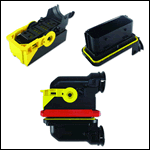When is a Plastic Connector the Right Connector?
Products made from plastic are thought of as cheap alternatives, but when it comes to connectors, they are sometimes the smarter option. Trevor Lee of LEMO answers the question: When is a plastic connector the right connector?

LEMO’s REDEL P plastic connector
Oftentimes, products made from plastic are thought of as cheap alternatives to metal products. This sentiment can be seen in a wide variety of markets, such as children’s toys, shower heads, consumer electronics, and furniture.
However, there are applications where metals cannot be used, and plastics are the preferred option. One example of such an application is medical devices. Some medical devices must be sterilized in between uses. The most common method of sterilizing in hospitals is with steam because it is the most cost-effective and conceptually simple method available, but the chemicals used to clean the sterilization equipment are not necessarily carefully controlled. Because of this, the chemicals will come in contact with the devices being sterilized, and the ions in these chemicals are often corrosive to metals. Plastics, however, tend to be resistant to ionic chemicals, so they are the superior choice for steam-sterilizable devices. This is just one application where plastics are preferred to their metal counterparts.
Electrically Insulated
In cases where the connector will be grounded through the shell, customers, patients, and other personnel could find themselves exposed to the grounding path. In most applications, this is of minimal concern, but for applications where exposure to this grounding path is unacceptable, such as in many medical devices and high-power connectors, electrically insulating materials can be used where physical contact is made. Therefore, using a plastic outer shell eliminates the chance of a user coming into direct contact with the grounding path.
Chemically Resistant
Even though commodity plastics might not be resistant to all chemicals, high-performance plastics will tend to resist common solvents and temperatures. These high-performance plastics, as noted above, will be much more resistant to ionic chemicals than the majority of metals, so they are preferred in certain applications.
Lightweight

LEMO REDEL SP plastic connectors
When component weight is critical, such as in aviation applications, plastics are a better option than metals. For the same geometry, plastic components will be lighter than metal components. Therefore, plastics are the clear winner in this category.
Less Expensive
Since plastics can be melted and processed at lower temperatures than most metals, they lend themselves to processing methods that can make more complex geometries in less time. For example, the time savings in injection molding applications makes the cost of plastic parts more competitive – even if the raw material cost is greater – than their machined metal counterparts.
With modern high-performance plastics, metals are not the only feasible option for quality connectors. The opportunities for plastic connectors are numerous and varied. Metal connectors should not be seen as better than plastic connectors: Metal and plastic connectors are two variants of a similar concept, and each has its strengths and weaknesses.
Trevor Lee is an applications and materials engineer at LEMO USA.





